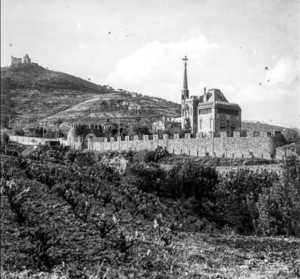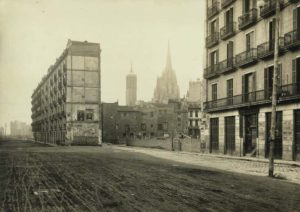May 16, 2024
By: Ferran Garcés

From the rooftop of Torre Bellesguard, one of the buildings that stands out the most is the Valldonzella monastery, home to Cistercian nuns. The distance between them is about a ten-minute walk. However, during the time of King Martín I the Humane, they were separated by over an hour. This detail is important to understand what happened in mid-May now 616 years ago…
The departure of a king
The last monarch of the Barcelona lineage resided in the ancient castle of Bellesguard, from June 1409 until May 12, 1410. He would never return. Death caught up with him a few days later, on May 31, at the Valldonzella monastery, but not at the one located a 10-minute walk away, the current one, but at another over an hour away, which was located in an area of the city called Creu Coberta today. The curious thing is that, after different locations, the monastery has finally settled next to the lands that King Martín the Humane abandoned on May 12, 1410. Not long after, his second wife, Margarita de Prades, would also do so.
The expulsion of a queen
After the death, shortly before, of his first wife and only son, the king had wedded young Margarita on September 17, 1409, in the chapel of Bellesguard, hoping to provide the crown with a new heir. Unfortunately, the king died, as we have said, the following year, and the new queen was not pregnant. This fact caused a serious succession crisis that only ended with the appointment of Ferdinand I of Antequera as the new king of the Crown of Aragon, during the Compromise of Caspe, in 1412.
During this tumultuous time, Margarita de Prades continued to live in the Bellesguard palace, on condition of being faithful to the memory of the late monarch. However, the young widow began a secret love affair with a nobleman from the court, Joan de Vilaragut y Álvarez de Haro. When the affair was discovered, she lost the right to reside in Bellesguard Castle, as well as other privileges. Then, in 1420, she also retired to the Valldonzella monastery, that monastery over an hour away from the current Torre Bellesguard. There she would profess as a nun until 1426. She would die three years later in an even more distant monastery, that of Bonrepós, in Morera de Montsant, in the Priorato.
Notes
(1) “The Valldonzella monastery was, first (1237), near Vallvidrera and, in the late Middle Ages, the community moved to Creu Coberta, outside the walls of Barcelona. This monastery was destroyed during the Reapers’ War (17th century), and the nuns went to reside in the Nazaret priory, inside the city, near the gate of San Antonio of the wall. This other monastery was burned during the Tragic Week (1909) and the nuns were charitably welcomed by the Valls family, in La Torre dels Pardals, in Guinardó. Meanwhile, the construction of a new monastery, the current one, was conceived, and in 1913 the nuns were able to move there, although the church could not be finished and consecrated until 1922.”
Extract from the leaflet of the Monastery of Santa Maria de Valldonzella, for more information: Albacete i Gascón, Antoni, and Güell i Baró, Margarida (2013), The Royal Monastery of Santa Maria de Valldonzella (1147-1922), Publications of the Montserrat Abbey
(2) For novel lovers, we remind them that these events are recreated in “The Heirs of the Earth,” the novel by the well-known writer Ildefonso Falcones, in chapter 17.




